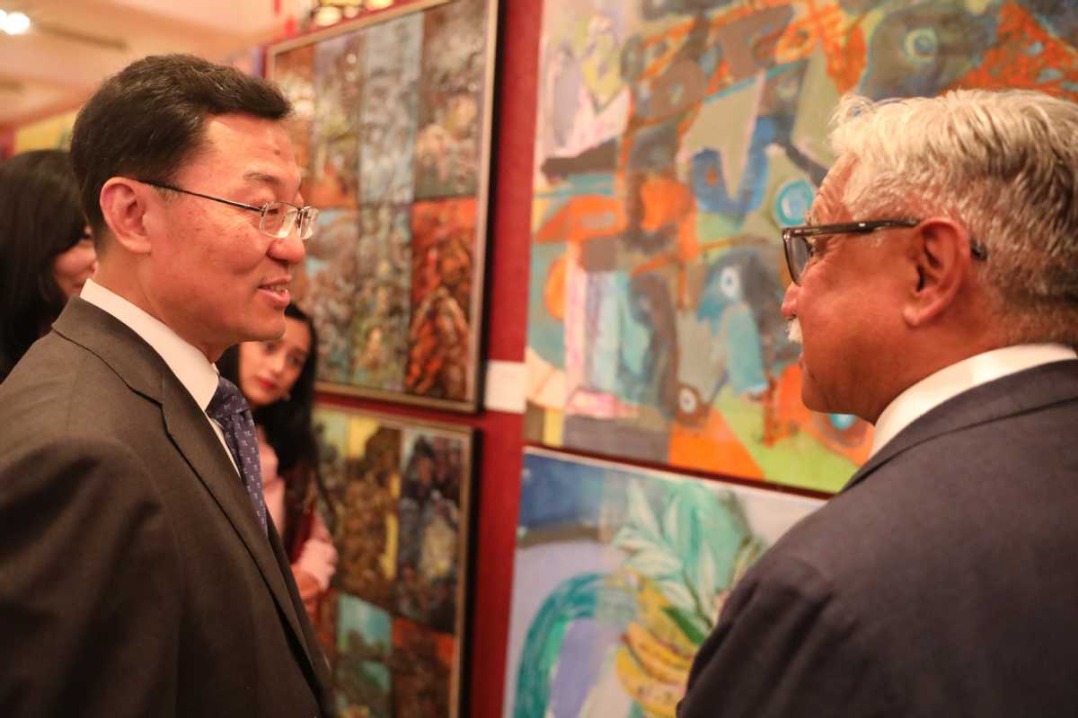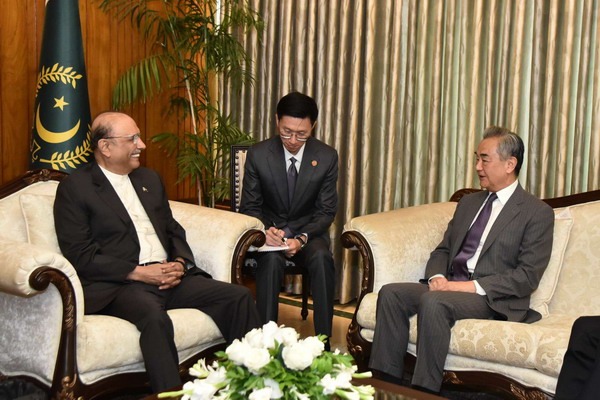INFINITE POSSIBILITIES

Report on the Digital Development of Global Higher Education
(Concise Version)
Secretariat of the Global MOOC and Online Education Alliance
Table of Contents
Foreword
The World in Action
Changes and Challenges
State of Development and Evaluation
Together for the Future
FOREWORD
The vitality and impact of a technology and the possibilities it unlocks depend on the needs of the times and society, as well as our desire to use it.
In our history, all areas have experienced systematic changes driven by technological advances. Harnessing the power of technology in quest of our visions has been the primary force behind human progress. Technological revolutions are often disruptive, beating traditional wisdom and expectations with their breadths, depths, and speeds. We have been faced with challenges and disasters of a similar scale of the Covid-19 pandemic many times in history; yet each time we manage to rise and do so with unprecedented progress. In this sense, every disaster offers opportunities.
About the digital revolution taking place today, much remains unknown, and it is difficult to predict the future. But one thing is certain. If we have confidence, insights, and visions, and create conditions and space for digital applications, digital revolution will bring infinite possibilities for higher education.
Only by following the trend can we stay relevant. In the 21st century, the new technological revolution and industrial transformation provide unseen opportunities. Knowledge, information, and data in digital forms have become key factors of production. The great potential of digital technology underlines the pressing needs for innovators across the globe in the digital age.
While offering opportunities to higher education, digital transformation also presents challenges. All countries are considering how to push beyond the limits of traditional higher education and taking actions to reshape higher education.
THE WORLD IN ACTION
In recent years, especially since the outbreak of the Covid-19 pandemic, all countries have realized the strategic importance of digital transformation and enhanced top-level designs to cope with the challenges. Strategic actions for the digitalization of higher education have been incorporated into their national frameworks of digital strategies, plans for priority areas of education, and special programs for higher education. International organizations have taken initiatives and worked with stakeholders to advocate, guide, and drive the digital transformation in the governance of higher education. Worldwide, digitalization is already a cornerstone for the sustainable transformation of higher education toward greater inclusiveness, fairness, and better quality. The whole world is in action, seeking progress by constantly reviewing lessons and achievements.
A study of the global higher education landscape shows that many countries have considered digitalization a strategic initiative and an essential path to the quality and sustainable development of higher education. Although each country has its own priorities and characteristics, common patterns do emerge from global actions.
Action 1: Systemic reform for an inclusive, fair, and resilient ecosystem of education. Many countries have leveraged the strengths of information technology in interconnectivity, openness, and accessibility to promote education equity, innovate teaching methods, and build new schooling models, as well as to modernize education governance and establish an ecosystem featuring "learning for all, anytime, anywhere." For example, China's Action Plan for MOOCs in the Western Region facilitates trans-regional sharing of high-quality education resources through digital technologies. Malaysia's Open and Distance Learning Project, which started the Open University Malaysia and Wawasan Open University, has expanded access to higher education. In its Vision 2025 for Higher Education, Pakistan stresses education equity through intelligent education. France has launched the France Digital University (France Université Numérique) to facilitate access to diverse and high-quality university courses. Kenya is committed to building a nationwide digital education system that connects all kinds of schools and knowledge centers.
Action 2: Upgrading infrastructure to consolidate the foundation for digital transformation. As digital infrastructure is developed, information networks, teaching equipment, public service platforms, and innovative applications have become the foundation for resilient higher education and digital transformation of education. The Asia-Europe Meeting Education Ministers' Meeting (ASEMME7) highlighted the opportunities of digitalization for connectivity and collaboration between Asia and Europe, proposing that all students and educators have access to a digital learning device. The United States encourages technology giants such as Google, Microsoft, and Apple to enter the education market and provide software, hardware, and technical support for the digitalization of education. Japan has implemented a five-year plan (2018-2022) to improve ICT infrastructure for schools, highlighting AI and other advanced technologies in improving the information environment. Mozambique is implementing the "One Student, One Computer" initiative. South Africa and Jordan ensure that students have access to information tools through laboratory renovation, equipment upgrade and ICT technology iteration.
Action 3: Technology-empowered classroom revolution. Teaching and learning empowered by digital technology is the most important scenario of education digitalization. As intelligent technology is integrated into education, pedagogy in higher education institutions is undergoing profound changes, giving rise to a variety of teaching approaches and providing learners with an immersive, interactive, and personalized learning experience. "Steering Tertiary Education: Toward Resilient Systems that Deliver for All", a research report by the World Bank emphasizes expanding the boundary of schools and labs through VR and AR technologies. Singapore requires teachers to use AI for data collection, analysis and application, and personalize homework assignments according to individual aptitudes. New Zealand is promoting the digital transformation of teaching and provides demo classes for teachers.
Action 4: Services for personalized learning and lifelong learning. The systematic changes and infinite possibilities brought by digitalization provide conditions for personalized learning and lifelong learning, which, in turn, creates new demands for high-quality online resources, online learning platforms, and certification of learning results. In 2022, China launched Smart Education of China (SEC) for higher education, the world's largest public education platform by number of disciplines, courses, and users. Thailand has set up a national Massive Open Online Course platform (Thai MOOC). Egypt provides online learning opportunities via Egyptian Knowledge Bank (EKB), a public platform of education resources. At the same time, countries are establishing qualification and credit mutual recognition systems for digital learning. India has issued its Credit Framework for online courses through SWAYAM, stating that no university shall refuse any student for credit mobility for the courses earned through MOOCs. Nigeria adopted the National Policy on ICT in Education, laying out a policy framework for digital education.
Action 5: Improving digital competence to unleash the potential of ICT. A key component of global strategic actions in digital transformation is to build the capacity of teachers and students through digital skills training. The purpose is to illustrate digital learning methods, help learners use digital learning tools, and foster digital thinking. The UNESCO Institute for Information Technologies in Education initiated the project "Teacher Capacity Building with AI and Digital Technologies: E-library for Teachers," which provides educators with advanced digital resources and AI-based capacity building solutions. China has issued the Action Plan of AI-based Innovation in Colleges and Universities and the Action Plan on Improving Digital Literacy and Skills for All to improve digital literacy and skills of the entire population. Vietnam has announced its vision to become a digitalized country with lasting prosperity and qualified digital citizenry by 2030. Saudi Arabia adopted the National Transformation Program (2016-2020), proposing efforts to improve the quality of teacher training and develop teachers' capability. Australia, Hungary, Finland, and Canada have issued digital capacity building plans that prescribe the digital technology to be commanded by students and the environment to be created for training digital skills. The capacity of college faculty and administrators in digital teaching, management and research is critical to higher education transformation.
Action 6: Improving supports for quality assurance. In line with the digitalization of higher education, countries are supporting quality assurance of education through multi-dimensional QA systems, the monitoring and analysis of teaching quality data, multi-mode online evaluation and certification, and mini-certification of courses and majors. By implementing the Digital School Initiative, UAE provides certified online education for students in the Arab region and other parts of the world who have no access to formal education. Lebanon adopted the National Education Strategic Plan, which proposes a blueprint to improve teaching quality with ICT. Germany's AI Campus project highlights data skills in AI, aiming at higher capacity of data use and evaluation and its classroom application. Universities in Russia have established an online platform that connects universities with teachers, parents, and students, allowing everyone to access the teaching contents and provide feedback. Turkey issued the Procedures and Principles regarding Distance Education in Higher Education Institutions, setting rules for distance learning majors and courses offered by public universities and private foundation universities.
Action 7: Using crises to provide international and diversified learning opportunities. The Covid-19 pandemic has exposed and aggravated the weaknesses and disparity in education supply and the poor capacity to sustain learning in emergencies. However, the crisis has also accelerated the digital revolution in higher education around the world, increasing the penetration, practices, and innovation of online teaching. Through diversified approaches, countries have co-built and shared high-quality online resources. Experience has thus been accumulated for post-pandemic education reforms to ensure orderly teaching and learning that accommodates multiple settings. During the pandemic, China responded with a learning-from-home scheme in all kinds of schools and colleges across the country. In 2020, a total of 1.1 million online courses were offered, with 3.5 billion attendances. EU has sped up the development of new teaching modes in the post-pandemic era, with a focus on online learning, to further digitalize higher education. Italy's National Plan for Digital Education provides an umbrella guide for efforts in this regard.
Action 8: Jointly building a secure and trusted intelligent governance system for complex situations. Any malicious cyber-attack may threaten the stability of the education network and the security of personal information, sabotage key infrastructure, and even threaten broader security interests. Countries and international organizations attach great importance to data security of their education networks. Various policies and measures have been issued on cyber security, data security and governance, and ethics of big data and AI to prevent and mitigate potential risks. In 2020, the International Telecommunication Union (ITU) released the Digital Skills Assessment Guidebook, proposing unified digital skills standards and providing technological safeguards for countries all over the world. The UK issued a guidance on Data Protection for Education Providers to safeguard education data. The National Cyber Security Strategy of Brazil proposes developing and offering courses on cyber security basics.
Action 9: Building an open, cross-sector, and trans-regional digital community. In recent years, through cross-sector and trans-regional collaboration and international cooperation at a strategical level, the international community has built digital platforms for improving higher education, people-to-people exchange, and mutual learning among countries. UNESCO worked closely with member states and associate members to renew the Asia Pacific Regional Convention on the Recognition of Qualifications in Higher Education and established a global mechanism for mutual recognition of higher education qualifications. With China's sponsorship, the Global MOOC and Online Education Alliance was established, where renowned universities and platforms from 14 countries have worked together to promote bilateral and multilateral cooperation to innovate education technology. Laos, Sri Lanka, Cambodia, and Mongolia, with international aid, have promoted digital transformation of higher education and implemented training programs for ICT practitioners. The Danish government launched the Digital Growth Strategy 2025 in partnership with 80 companies, research institutions, and trade associations, designating digital education as a new subject.
Digitalization is disrupting traditional philosophy and modes of higher education, creating a universal demand for diversification, personalization, and modernization. Today, digital transformation of higher education shows three trends.
Trend 1: Systematic transformation of higher education with digital technology. As digital economy becomes the new engine of global growth and social development, it is imperative to foster capabilities such as critical thinking, cooperation and communication, problem solving, and human-computer interaction. The demand for personalized, diverse, flexible, and high-quality education necessitates innovation in higher education, hence the global trend to transform and improve higher education with digital technology.
Trend 2: Building more resilient higher education in response to the Covid-19 pandemic. The Covid-19 pandemic has extensive and profound impacts on global education and reveals vulnerabilities of higher education. However, the large-scale exercise of online education since the pandemic has bred new philosophies, practices, and digital applications, offering unprecedented opportunities for online learning worldwide. It was forecast that in the post-pandemic era, countries would further empower higher education with digital technology to withstand future crises.
Trend 3: Reshaping the philosophy, modes, and practices of higher education with SDGs. As a pillar for the sustainable development of humanity, higher education and sustainable growth and social development are mutually reinforcing. A core task of higher education is to anchor sustainable development in the digital age. To meet the education goal (SDG4) under the 2030 Agenda for Sustainable Development, countries have adopted long-term strategies for education to ensure inclusiveness, equity, and sustainability in higher education. Remodeling the philosophy, paradigm, and practices of higher education and moving closer toward the common vision of high-quality higher education for all has become the common wish of the global community.
CHANGES AND CHALLENGES
Digital technology is leading to disruptive changes in the philosophy and paradigm of higher education. Through information technology, higher education has seen systematic changes in education methods, models of operation, governance, and supporting systems. Information technology has reshaped processes, structures, and cultures, introduced new drivers for growth, and revolutionized research and practices. It also has the potential to promote the all-round development of people and allow individuals and society to better adapt to an uncertain world.
I. Deep-level changes
As digitalization sweeps across the globe, the higher education community has responded to the changes through a scientific and proactive approach and provided more inclusive, equitable, and high-quality education for more students and the general public.
Change 1: Digitalization of education methods
New demand for skills in the digital era calls for systematic reforms of methods to foster people—reforms concerning factors such as the educational environment, resources, teachers, and teaching methods. The reforms also include efforts to transform the education philosophy and objectives, revamp the curricula, innovate teaching organization and management, and improve teachers' competence.
The integration of the cloud and local devices, which has reengineered the education environment, helps us transcend spatial and temporal limitations. The integration of online and offline teaching, and genuine and virtual realities makes students better learners. The inclusive, equitable, and high-quality supply of digital resources, the combination of big data and statistical analysis, and the growing computing power have made teaching more targeted. Digital literacy has contributed to teachers' competence. Digital training for teachers, AI-based teaching assistants and AI teachers combine to make better educators. In general, digitalization has led to innovation in delivery methods, teaching philosophies and practices.
Change 2: New models of operation
Traditionally, universities are operated around print technologies. Student data from enrollment to graduation is located in silos of different departments, resulting in fragmentation and incoherence. The penetration of information technology has sped up the emergence of new models of university operation, allowing university administration to be data-driven, systematic, and collaborative.
A unified digital management platform enables standard operations and real-time monitoring of student data from enrollment to graduation. As the process becomes more data-driven, intelligent, and standardized, it is possible to move the entire education process online. Digital technology also makes it possible to teach across campuses or create a university without a campus. It breaks the physical boundaries of traditional universities, improves the efficiency of operation, and makes it possible for everyone to learn anytime, anywhere. Countries around the world are working together to build cooperation platforms and mutual recognition mechanisms, through which experience is shared, standards are made, and credits, certificates, and degrees across the world are mutually recognized. Digital technology has reduced the need for physical resources in joint programs, broadened the channel for sharing international resources, and made educational institutions accessible to more people. In general, higher education has witnessed a trend of multilateral cooperation for shared benefits.
Change 3: Digitalization of the governance system
Digitalized governance is a natural result of digital transformation and is of great significance to higher education. Digitalization is reshaping the governance structure of institutions of higher learning. The traditional model of "rough" management and decision-making is becoming flat, platform-based, data-driven, and more refined.
Digital technology has given birth to digital management systems and optimized the teaching order and resources. Digitization has brought about significant changes in management. Digital management of online-only teaching and inter-university collaboration has been developed. Digital technology has empowered evaluation. A quantitative and intelligent evaluation system based on big data produces results that help universities provide more diversified and targeted education services.
Change 4: Digitalization of the supporting systems
Investment has been increased in digital infrastructure. Through constructive dialogues and multi-party cooperation, universities are making efforts to jointly create and share digital resources, harmonize competing interests, protect intellectual property rights, and establish education service supervision systems to ensure the progress of digital transformation.
Infrastructure is being built for new-generation information technology. More human, financial, and physical resources have been devoted to consolidating the material foundation for smart public education service platforms. Big data warehouses are being built to manage and share data generated from learning, teaching, and administration. An "educational brain" has been developed for data integration, and data application and analysis models established for students, teachers, and universities.
II. Challenges
The Internet has changed education, and artificial intelligence has brought about innovation. As the fountainhead of new ideas, the cradle of innovators, and the incubator of technology, institutions of higher education still face many challenges in their quest for reform and innovation in the digital era.
Challenge 1: Digital divide in education keeps widening
At the 2022 Transforming Education Summit, UN Secretary-General Antonio Guterres stressed that if digital revolution was not harnessed properly, it could exacerbate inequalities in education. Globally, differences in economic and social development have caused major gaps in digital learning. Covid-19 has magnified educational inequality caused by the digital divide. Access to devices and equipment, or the lack of it, makes a world of difference to students' learning under the new normal. Furthermore, as students suddenly lose supports provided on campus, such as teacher guidance, peer collaboration, and classroom settings, individual efforts and family environment exert a greater impact on learning effects, causing new deficits in student's inputs, learning skills, and information literacy.
Challenge 2: Teachers' digital competence needs to be improved
As leaders of the learning process, teachers need to acquire new competencies in the digital era. Some teachers, however, lack the awareness of integrating digital technology into teaching activities, the ability to use digital technology for teaching innovation, and the skills to support students' all-round development. Existing education and teaching methods are inadequate for the complex needs in the digital environment and insufficient attention is given to innovation of teaching methods. Efforts are needed to leverage digital technology, rebuild the teaching system, and give students more autonomy in learning. All these require teachers to promptly adapt to the digital era of higher education, improve their own digital competence, and be prepared for the digital transformation.
Challenge 3: Mechanisms and policies are not in place to support the sharing of digital resources
The collaboration and sharing of digital resources require stable platforms and policy support. An effective international coordination mechanism, however, is yet to be established and policy support needs to be stepped up. Countries need to build consensus, increase policy support, and strengthen collaborative innovation. In terms of integrated management and coordinated development of digital learning platforms and resources, many challenges are caused by institutional barriers and individual differences of learners, calling for enabling mechanisms and policies.
Challenge 4: Digital governance remains weak in universities
In terms of digital governance of universities, the main challenges are inadequate policies in support of curriculum development, credit certification, and online operation and management of educational institutions. To bridge the time lag between technological developments and university traditions, it is necessary to remodel the knowledge system and form open, flexible, diversified, and dynamic curricula. Digital education requires a flexible credit and degree certification system to enable learning across institutions. The number of disciplines and beneficiaries involved in whole-process online education is still limited. It is necessary to improve social recognition of whole-process online education to make it popular among the public. Digital transformation of governance is a complex project. Universities need policies to improve their digital operation capacity, form a digitally enabled organizational system, formulate incentives, and ensure funding and technology updates. Governments and international organizations need to offer guidance and bring the global higher education community together to address problems related to the open model of education governance.
Challenge 5: Inter-university and multilateral cooperation in digital education still lacks good practices
Education digitalization enables global interconnectivity and sharing. Building an efficient, accessible, and collaborative digital education system is a new task for countries in digitalizing higher education. In terms of inter-university cooperation, differences exist in the digital maturity and teaching quality among regions and universities. No best practices have been developed on course designs and teaching models while institutions expand their cooperation and try to maintain their unique strengths. In terms of multilateral cooperation, countries around the world still have problems of mismatched resources and incompatible technical and teaching standards, school systems, and legal systems. At present, there has not emerged a leading or representative cooperation model.
Challenge 6: New rules and mechanisms are needed for the digitalization of higher education
A supporting mechanism fit for the digital transformation of higher education is urgently needed to support changes in education, operation, and management. In terms of building a learning society, even in countries with universal higher education, individual learners still lack the motivation and ability for active learning, and the transition from traditional school-age "students" to life-long "learners" remains an unfinished journey. In terms of industry-university-research collaboration, there is a lack of adequate policy incentives, financial support, and social recognition, which has impeded the wide application of new technologies such as big data, virtual reality, and artificial intelligence. In terms of quality assurance and information security, the quality assurance mechanism for digital higher education, the information security ethics system, and the exercising of regulatory functions are challenges that all countries need to overcome.
STATE OF DEVELOPMENT AND EVALUATION
As an increasing number of countries and international organizations roll out digital initiatives, a revolution is taking place in higher education. The Digital Development Index of Global Higher Education will help us understand the digital trends, assess the state of development in each country, and develop strategies for digital transformation.
I. Stages of Digital Transformation of Higher Education
Digitalization of higher education started from and is driven by innovation in digital technology. It is achieved at three levels: macro, meso, and micro. At the macro level, the ecology of higher education is reshaped to serve the digital economy and society. At the meso level, the development model and paradigm of higher education is innovated. At the micro level, the whole education process is digitalized to forge a new path for higher education with the aid of data. In general, the digitalization of higher education can be divided into three stages.
First, the transition stage, where digital technology is integrated into higher education. In this stage, infrastructure is improved, software and hardware are mutually adapted, and digital technology is applied. Teaching activities break the limitations of time and space, and core elements of teaching, such as the objectives, contents, activities, evaluation, and the environment, are readjusted in the hybrid physical and cyber spaces to achieve optimal results. Based on the needs of learners and oriented to application, public education service platforms are built, integrated, and upgraded to pool high-quality resources and create a digital resource library.
Second, the transformation stage, where higher education is transformed through reengineering of the business processes in universities. Through the mining, analysis, and deep integration of data, all the elements and processes of education become digital. As the physical and cyber spaces are integrated, the infrastructure, environment and scenarios of teaching and research are fully digitalized. Digital transformation is completed for the university's organization, teaching, services, and governance. With digital technology, universities will have modernized their governance system and provided whole-process, smart, and personalized services for teaching and learning to meet diversified demands.
Third, the intelligent stage, where the ecology of higher education is reshaped to break the boundary with society. With the application of information technology represented by artificial intelligence, higher education can better satisfy the needs of the people. By this time, services are more targeted, knowledge sharing more efficient, management more detailed and user-friendly, and decisions more effective and efficient. Higher education is more equitable, where everyone has access to quality education and teaching resources they need, and a balance between quality and equity is achieved. Higher education is more open—data from multiple forms of learning are recognized and credits and degrees obtained from online learning are universally certified. Higher education is also more personalized, where education resources are allocated based on diversified needs and a smart learning space is built for each individual. In the intelligent stage, the philosophies, teaching paradigms, and governance of higher education are completely transformed to empower learners and create a new education ecology.
II. The Digital Development Index of Global Higher Education
The Digital Development Index of Global Higher Education intends to achieve three objectives: first, to capture the global processes and trends of digital transformation in higher education; second, to measure the digital transformation level of higher education in various countries; and third, to provide a benchmark for digital transformation strategies of higher education worldwide.
The index is developed according to the requirements for digitalization of higher education and by reference to domestic and international research and practices. The system has four primary indicators: digital capacity, digital schooling, digital management, and digital support; 10 secondary indicators; and 18 specific attributes (see Table 1), focusing on the digital transformation of higher education at the national level and presenting an overall picture of the world's higher education.
Table 1 The digital development index of global higher education
Primary indicators Secondary indicators Specific attributes
Digital capacity 1. Digital accessibility 1. Number of national public digital learning platforms
2. Proportion of schools possessing or using school-level digital learning platforms
3. Number of digital learning spaces per school
4. Number of mobile terminals per capita
5. Broadband connectivity for digital transformation
2. Education
resources 6. Number of MOOCs
7. Number of electronic databases per school
8. Number of discipline-specific software tools
3. Teachers' digital competence 9. Teachers' digital competence
Digital schooling 4. Teaching mode 10. Average online study time of students
11. Proportion of schools with a large-scale application of online courses, blended learning, and flipped classrooms
5. Degree certification 12. Number of online degree programs
Digital management 6. Internal governance 13. Digital management system
14. Digital management platform
7. External governance 15. Information security regulation
Digital support 8. Policy support 16. Strategic planning
9. Financial support 17. Allocation of financial resources
10. Manpower support 18. Percentage of digital personnel
TOGETHER FOR THE FUTURE
It is the mission of higher education to explore the unknown world, solve problems faced by humanity, promote people's all-round development, and create a better world for all. In the future, digital revolution will create unlimited potentials and a brand-new landscape for higher education.
I. Missions and Objectives
The digital transformation of higher education will advance in both physical and human terms to create a more inclusive and equitable higher education system that provides quality education and accomplishes new missions and objectives.
First, we need to adopt a more people-centered education philosophy. Higher education in its new form should foster people fit for a digital society by attending to individual needs, embracing openness and diversity, and emphasizing all-round development of students. For this purpose, intelligent technology should be integrated into the whole process of teaching and learning, management, and services, and the needs of groups and individuals should be balanced in the large-scale education supply. In this way, equitable, quality education can be achieved to ensure the free, comprehensive, and personalized development of humankind.
Second, we need to build a more intelligent education process. With the support of digital technology, the education process will be rebuilt through deep analysis of data. Teaching and research will be carried out in an intelligent way and the teaching, research and service scenarios will be digitally enhanced. In a word, digital technology will be mainstreamed in the whole process of teaching and learning and used to provide intelligent and personalized services.
Third, we need to adopt more diversified approaches in education evaluation. With artificial intelligence, big data, and cloud computing, teaching can be evaluated through diversified, process-based approaches that produce more accurate results. A fast, intelligent, and comprehensive analysis system that monitors, evaluates, and manages the whole process of teaching and learning should be established. Innovative digital evaluation tools should be developed to comprehensively record students' learning experience, analyze their performance and capabilities, propose personalized study plans, and improve learning effects. The scale of education will thus be achieved simultaneously with personalized teaching.
Fourth, we need to foster an educational culture that values openness and connectivity. Higher education culture in the new form requires a culture of openness and connectivity. As digital transformation continues, significant changes will take place in the educational environment, school organization, and educational systems. Accordingly, the traditional culture of education in material, institutional, and psychological terms should be updated to ensure the quality of higher education.
Fifth, we need to provide individualized education services. Universities need to create an intelligent and open environment for education, provide comfortable living conditions for teachers and students, and offer personalized and innovative services to meet the needs of teachers, students, and administrators. Education governance based on big data analysis will support scientific decision-making and improve the efficiency of administration.
Sixth, we need to build a higher education system that values sustainability. Digital technology helps educators understand the principles of higher education, summarize good practices, and improve the quality and efficiency of education, thus contributing to an open, sustainable, and resilient higher education system. Meanwhile, digital technology helps students acquire knowledge, values, and behaviors needed for sustainable development and foster a rational thinking on sustainability and lifelong learning.
II. Proposed Actions
The Global MOOC and Online Education Alliance proposes that governments, international organizations, universities, platforms, and enterprises work together to accelerate the digital transformation of higher education and create a better future of digital education.
(I) Building a Global Higher Education Community for Digital Transformation
Digital transformation is a future-oriented, systematic, and holistic process of changes. We call for solid top-level designs through a global community for digital transformation of higher education. We are committed to all-round development of students and the integration of technology and education. We undertake to improve digitalization of public infrastructure, management, service and support systems, digital governance systems, and global cooperation networks. We undertake to promote the development and application of the Digital Development Index of Global Higher Education, bridge the global digital divide, and create an inclusive, equitable, and high-quality higher education.
(II) Promoting a New Paradigm of Digital Education for All-Round Development
The all-round development of students is a concept that higher education must uphold. We call on universities and colleges around the world to update their philosophy, contents, and methods of education, study the principles governing students' growth and success in a digital society, and improve the digitalization in higher education. We undertake to promote transdisciplinary studies to build a new paradigm for education and research. We undertake to strengthen digital literacy training and evaluation of teachers and students to foster graduates who are needed by digital society and who can lead in the technological and industrial revolution to promote global development and human progress.
(III) Applying Technology in a New Model of Higher Education
Emerging technologies will promote the digital transformation of all factors, processes, and dimensions of higher education and can be used to form an intelligent and connected global higher education system that integrates online and offline learning through multiple technologies and strengthens the relationship between people and technology. We call on all universities and colleges around the world to apply emerging technologies, reshape higher education with technology, and use technology to advance schooling models, management systems, and support mechanisms. We undertake to strengthen cooperation between industry, education, and research, apply digital technology to higher education, and jointly build intelligent public service platforms, smart education tools, and educational big data resources. We undertake to develop smart campuses and online universities, explore hybrid and smart teaching, provide teachers and students with an immersive and virtual online learning experience, and realize whole-process and all-round education for all students through virtual-real integration. In addition, we undertake to take advantage of technology and computers to promote continuous innovation in educational concepts, models, methods, and resources to accelerate the development of global higher education.
(IV) Strengthening International Cooperation for Open and Inclusive Education
Global cooperation to share resources is vital for the expansion of higher education. Based on the global experience of sharing online open courses, we undertake to work together to develop technologies, create high-quality platforms, and share digital resources so as to build a more open, inclusive, and mutually reinforcing system of higher education around the world. We undertake to bridge the digital divide and promote equity in higher education. We undertake to give priority to education development and make educational resources accessible to all groups to foster values and skills needed in the digital age. We undertake to make use of global cooperation mechanisms to support efforts of higher education institutions in developing countries to upgrade their policies, hardware, and software, as well as personnel qualifications for digital transformation. We undertake to promote a learning revolution and higher education transformation to help achieve SDG4 on equitable and inclusive quality education.
(V) Enhancing Services and Governance of Global Digital Education
Countries are encouraged to make available more quality higher education resources online and improve services to help elevate the standards of global higher education. We call for attention to the governance of educational big data and encourage efforts to improve the capacity of digital resource development, management, and application, with particular attention to data quality and security in data collection, storage, analysis, and mining. We undertake to take stock of the global experience in digital economy and education to improve the capacity of higher education data governance. We undertake to improve rules on global higher education governance, set quality standards for digital higher education, and promote course sharing and mutual recognition of credits and qualifications. We undertake to increase the availability of quality digital resources to society and strengthen data mobility across disciplines, spaces, and professions.
(VI) Upholding Educational Principles and Ethics
We undertake to follow technological ethics and advocate humanistic values. We will use legal, ethical, regulatory, and technical means to regulate the opening, sharing, application, and management of data. We will protect privacy and intellectual property rights, and positively resolve ethical issues in the application of new technology. True to our missions on education, we are aware of the limitations of technology and will develop technological standards and norms for higher education.
Technology is developed to serve the needs of people. As digital technology transforms learning, it makes education accessible to all people, regardless of their backgrounds and aptitudes. The contents of teaching can also be tailor-made for student's learning needs as opposed to the teacher-centered instruction. As a result, the learning capacity of individuals and the productivity of higher education will be further released, providing power and hope for universities, individuals, and society. We are convinced that in this process the global education community will establish closer cooperation and contribute to a community of a shared future for mankind.

































